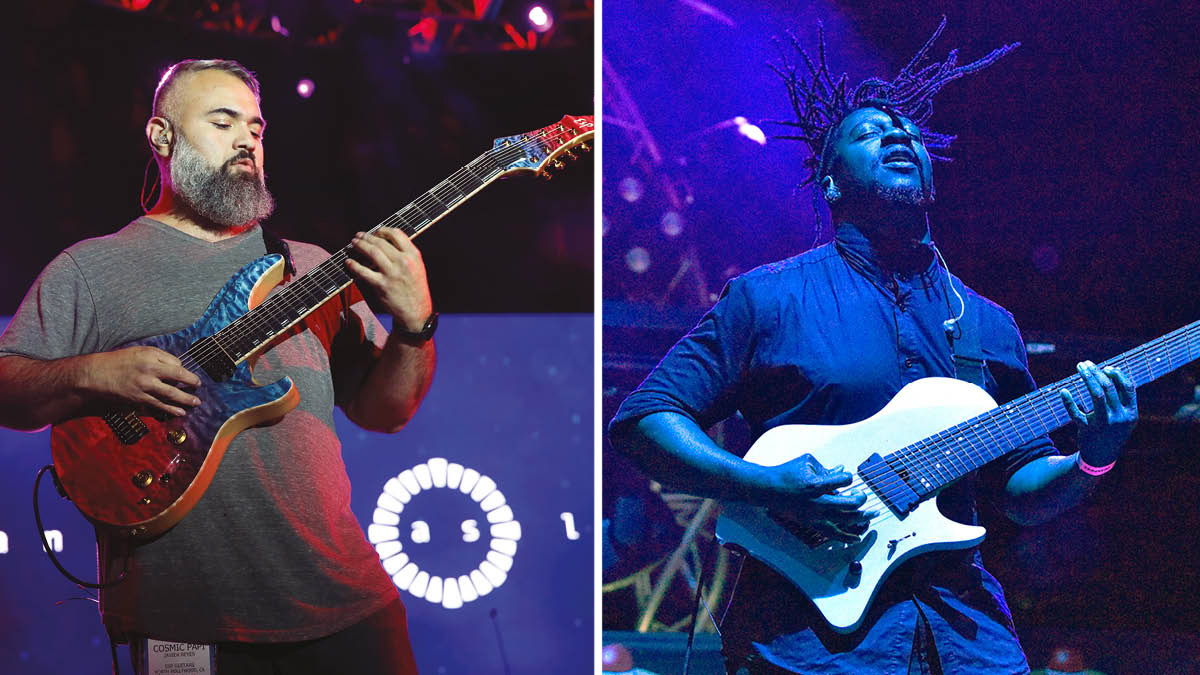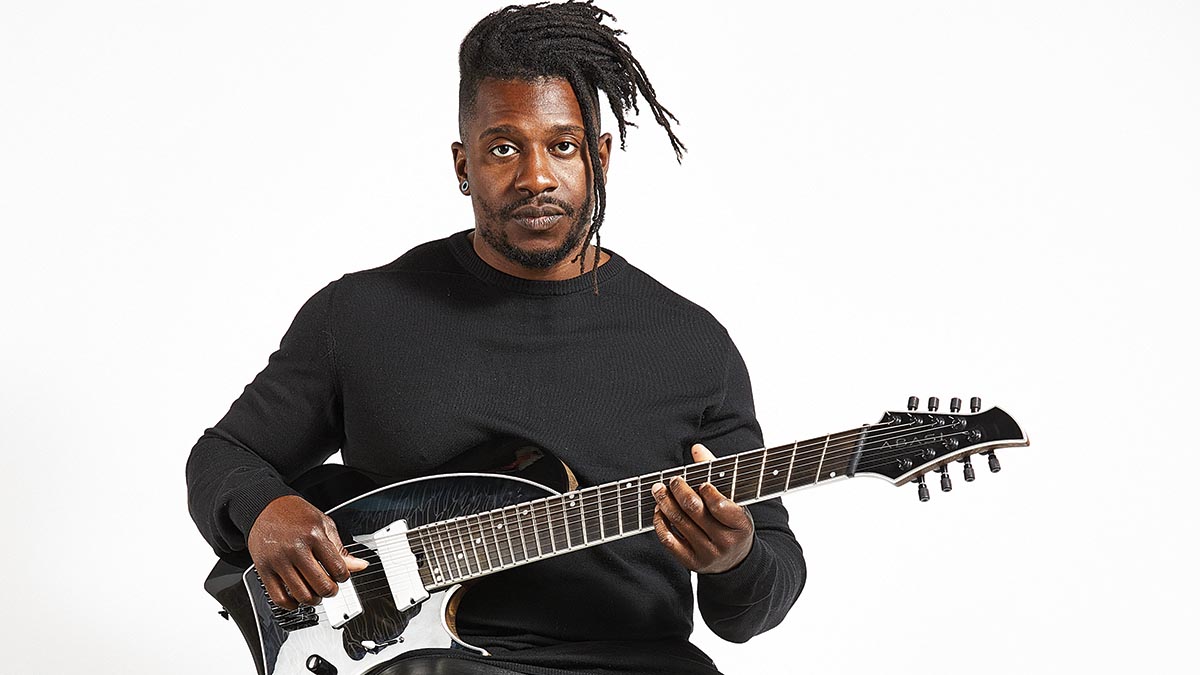Animals As Leaders’ Tosin Abasi and Javier Reyes on taking the maximalist “more is more” approach to their spectacular new album, Parrhesia

I call it ‘sharpening the knife,’” says Tosin Abasi, describing the approach he and his longtime Animals As Leaders guitar partner Javier Reyes adopted when recording the group’s super-aggressive fifth album, Parrhesia.
“On the past couple of albums, we explored a lot of different directions; we got very experimental and we did some fusion-y stuff. This time out, Javier and I consolidated the elements we wanted to incorporate and we went for a more bludgeoning experience.” He laughs. “That sounds pretty good, doesn’t it?”
For Javier Reyes, the decision to operate at this maximum intensity was a no-brainer. “We did the more ambiguous thing, so this album is our way of telling people, ‘Don’t get things twisted – we can still go hard,’” he says. “We like the fusion-y jazz stuff; otherwise, we wouldn’t have written it. But at the end of the day, our roots are in progressive metal. That’s the core of our fanbase – metal fans. So we wanted to go back and continue that train of thought.”
It’s been six years since Abasi, Reyes and drummer Matt Garstka issued an Animals As Leaders album (their last effort was 2016’s The Madness of Many). That’s the longest stretch between records since the band’s 2009 self-titled debut.
Abasi and Reyes first started compiling demos for the new set two years ago, during the first wave of the Covid pandemic, and they spent six months recording the album – four tracks were self-produced, while the remaining cuts were done in collaboration with the band’s long-serving producer (and founding member of the D.C.-based prog-metal band Periphery), Misha Mansoor.
When asked if the pandemic’s on-again, off-again lockdowns contributed in any way to the relentlessly belligerent nature of their new music, Abasi says, “It’s nothing we talked about, per se. I don’t think the album relates to the pandemic, but maybe some pent-up frustration came through. Basically, we just started molding the music, and we found that it was heavier than usual.”
Indeed, the nine tracks on Parrhesia contain some of the most vicious moments Animals As Leaders have ever recorded. Conflict Cartography and Monomyth come at you like battering rams, with eight-stringed wonders Abasi and Reyes set on two modes: intense and high-octane intense.
Get The Pick Newsletter
All the latest guitar news, interviews, lessons, reviews, deals and more, direct to your inbox!
The aptly named Micro-Aggressions is a string-skipping punisher, with hot beams of blitzing riffs firing off in every conceivable direction – before you have a second to duck, another fierce salvo is on the way.
Gestaltzerfall – now there’s a mouthful – flies across the sonic spectrum as the two guitarists summersault over each other while trading spiky, meticulously targeted body blows.
The idea of being centered on truth and being committed to that has always been a compass we’ve used to direct how we write music
Tosin Abasi
There are brief reprieves in the assault – the whacked-out and woozy guitar lines of The Problem of Other Minds float over a rippling, hypnotic rhythm bed, and Asahi is a surprisingly gentle mood piece highlighted by graceful, legato soloing – but for much of the ride, Parrhesia will have listeners gripping their seats for dear life.
For those who have yet to Google, the definition of “parrhesia” is “boldness or freedom of speech” and, in some instances, “to speak the truth.” Abasi admits he thought it was “a cool word that encapsulates our approach to making sounds,” but he also sees it as a metaphor for the band’s philosophy.
“There’s kind of an iconoclastic element to what we do that cuts against the grain, but it’s true to us. Considering the cultural discourse right now, there’s so much being said, and I think just the idea of being centered on truth and being committed to that has always been a compass we’ve used to direct how we write music.”

As virtuosos, do you two feel a responsibility to push yourselves on the guitar at all times? Do you ever find it a burden?
ABASI: “For me, it is. One hundred percent. The competitive element to playing guitar is a driving force, but it also can be a curse, because the likelihood that you’re 'the best' is going to be pretty low. There can be an annoying element to virtuosity.
“Let’s say you want to express yourself a certain way in a song, but then you feel like the idea you wrote is too simple because you’re known for writing complex things. So that might mean you won’t go in that direction because you feel locked into this idea that your musical value is musical complexity.”
Sounds frustrating.
ABASI: “Sure. For me, as a lead guitar player, I see so much insane talent in the world right now. It almost makes you go, 'Why even attempt it?' When that happens to me, I have to remind myself that it’s obviously more about unique contributions.
“I feel like I have some musical ideas that are worthwhile, and they’re more about individuality as opposed to some competition for cleanliness, speed and stuff like that. [Laughs] Not that I haven’t been guilty of participating in all that myself. I just think it can be a double-edged sword, for sure.”
Two of your first videos from the album, Monomyth and The Problem of Other Minds, featured dance troupes interpreting the music. Do you have any kind of visual component in mind when you’re writing?
REYES: “There’s no visual component in mind during the writing process, but I think we’ve always wanted to have some type of visual that’s equally as strong as the music. Some of our past music videos haven’t been of the same caliber as the two you mentioned, but we were just kind of following along with what the label wanted.
“This time around, we wanted to have something very compelling that partnered with the music, but that came after the writing. It’s not like Tosin shows up and says, ‘By the way, when I’m playing this riff in 11/16, I think we should have a video with contemporary dancers.’ [Laughs]”
It’s not like Tosin shows up and says, ‘By the way, when I’m playing this riff in 11/16, I think we should have a video with contemporary dancers’
Javier Reyes
ABASI: “My partner is a visual artist, and we work together on some stuff – not for Animals As Leaders, but I do think we approached her about doing the album artwork. Then she had some ideas for a music video, and I think a lot of the Monomyth and Problem of Other Minds were visual ideas she already had.
“In the past, Javier and I talked about getting dancers to do something to visually represent the music, but I think we were thinking more contemporary, as in urban, where it was very rhythmically synced. We thought that that would be fun. But then it took on a different, more high art direction.”
How do you two go about complementing and contrasting your guitar tones? With so many strings to work with, I imagine there are a lot of frequencies bopping around.
REYES: “In the writing process, we don’t necessarily worry too much about our tones clashing. It’s all very section focused. If the rhythm guitar needs more low end, we’ll put more low end on it. Things change a lot with us.
“During recording, Tosin might play one part and I play another, but when we get on stage, it can be completely opposite. So we’re more focused on just what the song needs and what the recording needs, as opposed to what our individual needs are.”
When we were in the studio, my buddy had a bunch of relic guitars. He pulled out a Les Paul, we hooked it up, and it sounded great
Javier Reyes
ABASI: “It’s interesting to me, because as a guitarist your tone is super-personal. Jav has certain amp styles he likes – certain pickup voicings and all that stuff. And, of course, I do too. They’re similar, but they differ in minor ways.
“When we get together, we take a pretty utilitarian, greater-good approach of ‘I know that’s your favorite overdrive pedal, but it sounds weird in the mix, so we’re going to use this other thing.’ We’re very objective during mixing. Whether you like this or that, it’s all about how it sounds in the end.”
You’ve worked with Misha Mansoor in the past, and he’s obviously a very simpatico ear in the studio. I’m curious, though – have you ever considered bringing in somebody completely outside your wheelhouse?
ABASI: “That’s a really great question. A few years ago, we were really interested in that. There’s a Norwegian band called Jaga Jazzist; they remind me of progressive bands from the ’70s, but they have horn arrangements and hammered instruments and stuff. Anyway, the main guy in that band [Lars Horntveth] was someone who stood out to me as a potential producer.
“We’ve considered other people as well, but it’s just never worked out. We self-produce a lot, which has its benefits as far as defining the sound for ourselves. Every once in a while, though, we do reach out for outside influence, just to get some different results. Maybe in the future we’ll end up working with some other producers.”
REYES: “Given the complexity of our music, I think there’s some concern with finding somebody who can understand what’s happening with the guitar and drum parts. That’s been one of the benefits we have with Misha: he gets what we’re doing, 1,000 percent. In a lot of ways, he’s partly responsible for our sound. He and Tosin wrote the first album together, and so that kind of gave Animals As Leaders a habitat to exist.”
There are so many playing aspects to touch on in your new songs – almost too many. In Monomyth, there are these chugging chords at the end. They don’t even sound like a guitar; they sound like a door slamming.
ABASI: “We’re probably just palm muting. Right, Jav?
REYES: “Yeah, it’s just those chugs. I think it’s a combination of the amp tone with how we’re playing. It’s just a very aggressive chug. There’s nothing too crazy about it, but it is a little sick.”
Red Miso starts out dreamy and soothing, and then it turns super-scary. Did you ever think of just continuing the first mood and letting it be that?
ABASI: “It’s funny, but like I said, we set something in motion and we’re not really always sure what’s going to happen. On that beginning sequence, I was using an Eventide H9 pedal that has a stutter delay. I was just messing around with a clean tone and that delay, and that was the seed of the song.
We set something in motion and we’re not really always sure what’s going to happen
Tosin Abasi
“When we tracked it, that’s when we made musical decisions in real time: ‘OK, try this. Let’s add this. Try this section and accent these parts with heavy guitar.’ The song is a bit of a linear journey from dreaming to very aggressive. It could have ended up in a multitude of ways.”
REYES: “We try to think of how to get back to that first section and bring the song full circle, but things just happen naturally. With Red Miso, by the time we got to that crazy part in the middle where it’s just linear and nothing repeats, we were like, ‘OK, there’s no returning back.’ The song kind of just started directing itself at that point.”
Gestaltzerfall and Asahi have moments of beautiful legato playing. Between the two of you, who is the big legato guy?
ABASI: “I feel like maybe Jav is, because he’s got some classical slurs, like left-hand stuff.”
REYES: “Yeah. I don’t really alternate-pick that well, actually, so I rely on my legato.”
There’s an anxious quality throughout Thoughts and Prayers. Is the contrast to the title intentional, and is it supposed to be a bit of social commentary?
ABASI: “There’s a cynical take on ‘thoughts and prayers’ in that you have these events that are by the hands of men, but there’s this uniform appeal to something that isn’t man. I think at a point it started to just ring hollow.
We’re maximalists. More is more
Tosin Abasi
“It’s a layered thing, because the intent is one thing – you’re sending thoughts and prayers – but in effect, are you even doing anything? It’s kind of like the intentions there, but is it a way to not really have to do more?
“I think the juxtaposition is about a type of helplessness. Whenever you hear ‘thoughts and prayers,’ it’s because something terrible has happened. The song has a bit of a complex; the vibe of it is slightly off.
“There’s this cyclical melody that is almost major, but there are intervals that are slightly outside of what you’d expect, and it’s kind of mildly anxious. There’s an energy to it – it’s slightly dark, but it’s also hopeful.
On Micro-Aggressions, every 20 seconds there’s something new to listen to. But there’s one section with this blazing rock chord and some harmonized soloing. It sounded brilliant. Did you ever think of building a song from just that part?
REYES: “No.”
ABASI: “We’re maximalists. More is more.”
REYES: “It’s like an artist working in front of his canvas. We can think of having the one part because that’s what’s going to be played live, but at the same time, we’re just on this mentality of what the song needs. ‘Does it sound better with a harmony that maybe we can’t play live?’ In the end, it’s about the recording.”
Let’s talk about the guitars you used on the album. Tosin, are you pretty much using your Abasi Concepts guitars?
ABASI: “Yeah. I would say, except for maybe one solo, all my parts were tracked with my guitar.”
REYES: “There’s a few solos on which we ended up using a Gibson.”
ABASI: “Oh yeah, the Les Paul.”
REYES: “Which is very random – there were sprinkles of it. It’s kind of what we were talking about earlier – ‘What does the recording need?’ In a perfect situation, we would have one guitar for the entire thing, but in the process of what’s best for the mix, when we were in the studio, my buddy had a bunch of relic guitars. He pulled out a Les Paul, we hooked it up, and it sounded great.”
Javier, how about you? Did you mainly use your ESPs?
REYES: “No. All the rhythm stuff is with Tosin’s guitar. Again, it’s more of a utilitarian process. ‘Does the song need this or that, or are we going to add more difficulty by including another guitar and tone and whatnot?’”
By your own admission, you both push yourselves to make things complex. At the end of the day, though, do you ever just kick back and unwind by playing – oh, I don’t know – something like Taking Care of Business?
REYES: “No. [Laughs]”
ABASI: “I’ve been kind of getting into the blues, just like a fun…"
REYES: “By blues, he means Eric Gales.”
ABASI: “Yeah, Eric Gales and Joe Bonamassa and Josh Smith. But obviously, look, if I’m playing a type of music that has three chords, and each chord gets an equal number of beats, and those beats make up an even measure, I’m playing something a lot simpler than Animals As Leaders.
“That’s a different type of muscle, and it’s relaxing because there’s parts of my brain that aren’t counting complex time signatures. You get to express yourself in a different way. For me, maybe playing classical guitar is how I unwind and play something that is just a different energy.”
- Parrhesia is out now via Sumerian Records.
Joe is a freelance journalist who has, over the past few decades, interviewed hundreds of guitarists for Guitar World, Guitar Player, MusicRadar and Classic Rock. He is also a former editor of Guitar World, contributing writer for Guitar Aficionado and VP of A&R for Island Records. He’s an enthusiastic guitarist, but he’s nowhere near the likes of the people he interviews. Surprisingly, his skills are more suited to the drums. If you need a drummer for your Beatles tribute band, look him up.










